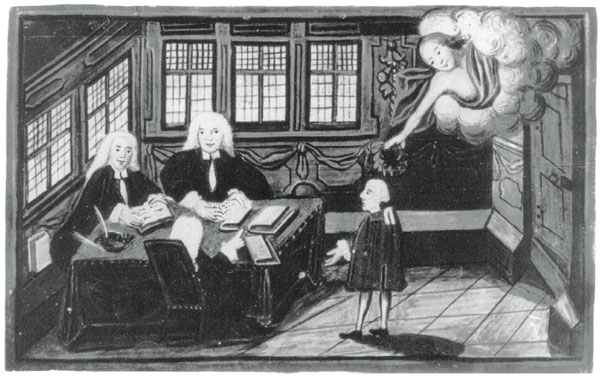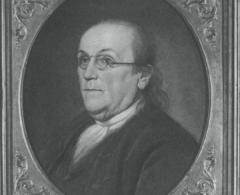
This Article From Issue
September-October 2006
Volume 94, Number 5
Page 466
DOI: 10.1511/2006.61.466
Academic Charisma and the Origins of the Research University. William Clark. vi + 662 pp. University of Chicago Press, 2006. $45.
In almost any way that one can imagine, Academic Charisma and the Origins of the Research University is an astonishing book. Earlier reviews have said as much. It is astonishing in style, voice, structure, method, conception, breadth and learning. It is full of arresting detail, which is joined (as the author, William Clark, says) to a "grand narrative." The book also possesses a chaotic freedom that, together with its self-conscious idiosyncrasies and irregularities, and odd typographical layouts, reminds one of Laurence Sterne’s 18th-century novel Tristram Shandy. Clark borrows from and adapts the ideas of important thinkers such as Max Weber, Marshall McLuhan, Northrop Frye and Michel Foucault to establish frameworks and nuances—drawing possibly too much from Foucault for some.
Those who work on the history and ethnography of homo academicus have often wondered why historians have not developed a systematic account of the evolution of this special kind of professional occupation. (The work of the French sociologist Pierre Bourdieu is too abstract to qualify.) Engineers, medical doctors and lawyers have been the subject of innumerable sociological and historical studies, but not the professors. The omission is strange because, as the late Harold Perkin said, academics comprise the "key profession," since they educate all the others.

From Academic Charisma.
We first encounter the rubric "professor" in the earliest periods of university history, but not until the 1700s does it assume its present meaning. Thanks to Clark, we now have a detailed and systematic understanding of the stages of role differentiation. We start with a world in which seniority and ascribed status matter. In the medieval period, academics, like other members of society, did not think of themselves primarily as distinct individuals with a unique personality; rather, they defined themselves in terms of the particular status groups (distinguished by dress and privileges) to which they belonged. Several centuries later, a new generation of Renaissance humanists began the process of self-seeking that eventually resulted in the Romantic conception of the professor as genius—as (to use Weber’s term) charismatic. Social standing was no longer ascribed; it had to be earned.
Clark very nicely and precisely takes us from the medieval chair—cathedra (the chair or throne of a bishop)—to the more modern chairholder at the center of a network composed of disciples, research libraries, seminars, institutes and laboratories. He provides us with lengthy accounts of the history of library cataloguing, the making and keeping of records, lecture and seminar formats, changes in the examinations (a subject that has attracted considerable historical attention), the doctoral dissertation, advanced degrees and the transformation of oral cultures into written ones.
The Jesuits of the Counter-Reformation were the precursors of a new professorial style that was more militant and talent-centered, but their formidable intellectual qualities were put at the service of a particular religious program located in Rome. Therefore the professor could not come of age until the birth of the modern secular state.
This observation is the linchpin of Clark’s analysis. After making it, he introduces a startling set of ideas: It was not the professors who created the modern academic profession; rather, it was the rationalizing, bureaucratic, market-conscious functionaries who served the various German states of the 18th century. Through site visits, the careful recording of facts, new methods of accountability and judicious use of budgets, government ministers forced the once-indolent professors to become hardworking and reputation-seeking. It was ultimately the state that created the syndrome of "publish or perish" and put us on the path to the large-scale research environments in which scientific work is pursued today.
In sum, an elaborate and successful deception was carried out.
Professors regarded themselves as autonomous, but in fact the universities in which they worked were manipulated to achieve the larger technological and bureaucratic aims of the modern state in competition with other states. Even the newly acquired personal identity of professors was a blind. At bottom they were only officeholders, paid by governments. Medieval academics may have been anonymous, but because they belonged to clearly defined status groups, they did not have to personally struggle with their identity or wonder whether they had sufficient charisma. Nor were they in danger of confusing who they were with the scientific instruments and methods essential to modern professionalism. Therefore the medieval academics were not alienated from themselves or, to use Clark’s word, "disembodied." We might also say, "denatured."
Clark is the rarest sort of historian, one who does exactly as he wishes. There is a real voice here. The observation extends to the writing, which is various. Sometimes the prose is clichéd in postmodern fashion—Clark likes to use occults as a verb—but in another direction he also likes to repeat the phrase "clouds of unknowing." At other times the writing is provocative and playful, if also a mouthful: "the simulacrum of a public-private self cast in the rumor-mill of the market, an effect of the power of ministerial paperwork and the fame machine." And many times the prose is purposefully funny and anything but dryasdust academic writing.
No summary can do justice to a book so relentless in analysis and so rich in original source material. But some criticisms are required. Bringing macro- and micro-history together is always an elusive, if necessary, aim of historians. The exhausting detail of Clark’s work, the language skills, analytical methods and fascinating sources that he commands need a larger framework if they are to make sense, and that larger framework is perforce sketchier. Thus we encounter some rather gigantic generalizations—for example, homo academicus germanicus protestantus. This is intended to be a summary phrase involving Weber’s protestant ethic of work, but it is somewhat open historically and hard to connect with the precise information supplied in the specific contexts.
Similarly, Clark occasionally offers throwaway conclusions: "Perhaps it ought not to surprise us that capitalist England saw the most refined development of the early modern grading system." This follows from a discussion of the evolution of the Cambridge honors examination degree of the mid-18th century, which has long attracted attention as the possible origins of the merit principle in ability sorting. But the connection between English financial capitalism or early industrial capitalism and aristocratic and Anglican-dominated Cambridge is not at all obvious. Just how market discipline may have somehow led to an important change in the structure of examinations, or is related to it, is by no means evident.
In writing about the development of academic culture in the United States, Clark attributes far too much influence to Oxford and Cambridge. More important for the history of the academic profession and university organization in America, and throughout the British Isles, was Scotland, which is only mentioned in passing toward the end of the book. The Scots and the Scots-Irish were the great educators of the English-speaking world well back into the 18th century, providing leadership, teaching and curricula. It was on the Scottish professorial and professional-school model that Victorian university expansion took place throughout the United Kingdom. To have had Clark’s superb analytical skills directed toward Scotland would have been illuminating indeed.
The focus on structures, systems and organizations is critically important, but readers should realize that it moves the story in a worrisome direction. The usual way of discussing the growth of the academic profession is to stress the importance of disciplinary and subdisciplinary specialization. Professors are highly educated men and women driven by a passion for and love of knowledge. And knowledge begets knowledge. New ideas and applications of those ideas are created in laboratories and classrooms and account for the strength of the advanced industrial and high-tech democracies. In this alternative and conventional narrative, the professors, as creators of knowledge, are in charge of their own destinies. Clark’s emphasis on the state as the ultimate, if indirect, source of intellectual creativity therefore challenges received opinion, but it also challenges a certain high-mindedness about the pursuit and embrace of knowledge that the inherited account assumes. The corrective is necessary; but it also a corrective derived from a particular skepticism about current academic values that Clark does not in any way conceal.
That skepticism is widely shared today. Even four decades ago, Clark Kerr, who was then president of the University of California, warned about the damage to academic culture caused by the "rise of the Research Grant University." In the final chapter of Academic Charisma and the Origins of the Research University, William Clark joins a large number of critics in finding fault both with the managerial and corporate styles of governance present in research academia today and with the grandstanding and self-seeking that have encouraged institutions to purchase faculty. It is assuredly difficult to recognize the remains of collegial authority in today’s universities. The heavy emphasis on wealth generation has produced university-government-industrial alliances that are often disturbing, compromising our sense of the proper use of scientific inquiry and making us wonder about the true strength of professional values. However, this is a complicated story of losses and gains. This tailpiece of the book is its least original part, but in fairness it does tell us where Clark began his retrospective investigations.
Lay readers will find the book’s methodological and intellectual sophistication difficult to grasp. They also may not appreciate its deliberate irony. Clark uses irony in classical rhetorical fashion to emphasize the unexpected outcome of the story that he is telling and at the same time to distance himself from a conclusion of which he disapproves.
All in all, this is a brilliant book. The styles and methods may be recognizable, but the whole is daringly new, exciting and disturbing.

American Scientist Comments and Discussion
To discuss our articles or comment on them, please share them and tag American Scientist on social media platforms. Here are links to our profiles on Twitter, Facebook, and LinkedIn.
If we re-share your post, we will moderate comments/discussion following our comments policy.